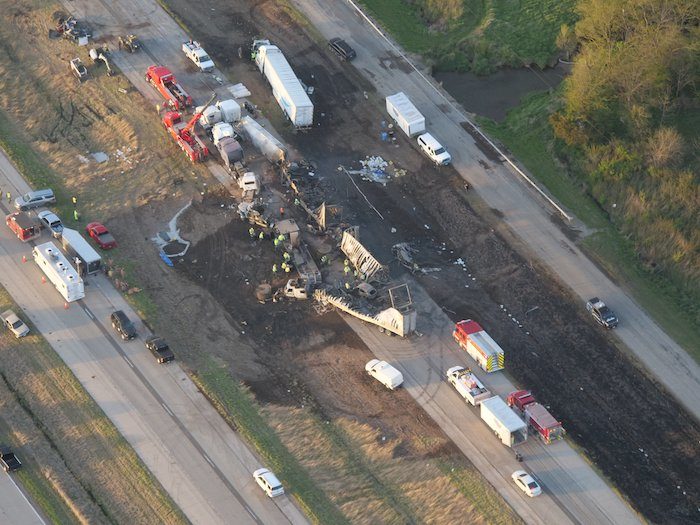Encouraging more farmers to adopt no-till and other conservation agriculture practices is a difficult task, but it's one that's critical to public safety, as demonstrated by a deadly dust storm crash in central Illinois in May.
A dust storm crash that occurred on I-55 in in Montgomery County, Ill., May 1 killed 8 people. 72 vehicles were a part of the crash, and in addition to the deaths, dozens more people were injured.
Following the I-55 dust storm crash, No-Till Farmer held a panel discussion about the implications of conventional tillage as well as how to incentivize the use of conservation ag practices like no-till to minimize soil movement off the field. The panel consisted of Rick Clark, a no-tiller from Williamsport, Ind.; Randall Reeder, a No-Till Legend and author of an article outlining how tillage was to blame for the crash; Loran Steinlage, a No-Till Innovator and No-Till Farmer's 2023 Conservation Ag Operator Fellow; and Rick Kaesebeir, a no-tiller from just north of Springfield, Ill., only 35 miles from the crash site.
Regulation Model
Government regulation is an option to decrease tillage, and it's something the U.S. attempted in the past — to little success. In the 1990s, the National Federal Crop Insurance Reform Act of 1994 helped farmers in the category of loss prevention through subsidies. The act made it mandatory for farmers to be a part of the crop insurance program to receive benefits such as deficiency payments under price support programs and certain loans. Catastrophic (CAT) coverage was created due to the program being mandatory. The program would cover farmers' losses that exceeded 50% of their average yield paying 60% of the price established for the crop for that year. The premium for CAT was subsidized entirely. In 1996, the mandatory participation requirement was repealed.
Jim Moseley, former deputy secretary of the USDA, talked about his experience in trying to regulate tillage practices. Moseley initially thought federal policy needed to be in place to mitigate the destruction of the soil when he traveled to Washington D.C. in 1989.
"Bill Richards was the chief of Soil Conservation Service, and I'd invited him in to do that because he was a no-till farmer. We had to implement conservation compliance," Moseley says. "Bill was well known as the father of no-till way back when. He did a lot of development work on his own on his farm. What Bill and I found out was we were having great difficulty with these farmers because they said, 'Well we don't have the money.' We recall it being difficult at the time. 'We just don't have the money to make the conversion to no-till.'"
When the Clinton administration took office, not much more progress was made. Both Mosely and Richards made progress on their own proposal for legislation once they'd left working for the federal government.
"I remember the weekend I went over to Bill’s," Moseley says. "I said ‘Bill, we have to figure out how to get these farmers the cash to do what we need to do.' Turns out it’s easier to pass legislation when you’re outside the federal government than when you’re setting aside as an undersecretary. We wrote what we called the Environmental Enhancement Incentive program."
The point was to accelerate implementation, says Moseley. He also acknowledged many of the same problems still exist today, and he emphasized that legislation can have an impact.
There’ve been attempts in the past to “legislate the problem away," but that hasn’t seemed to work given how many dust storms still occur. Among the other things put into place from a legislative perspective was the Risk Management Agency (RMA). RMA was created to administer Federal Crop Insurance Corporation (FCIC) programs and other non-insurance-related risk management and education programs that help support U.S. agriculture.
Clark says that a possible tiered incentive-based payout system could be the best way to implement more conservation practices on U.S. farmland. The basis would be that the government would identify conservation practices.
"If you do not implement any soil health practices, you don't get any subsidy payments," says Clark. "If you do one or 2 things, you get 20%. If you do four, you get 40%. If you go all the way, you get all of the payment. It's pretty simple. If they don't want to participate, they get no subsidy payment. It's that easy."
Can't Force Change
The panelists believe more deadly storms similar to the one on I-55 will occur if changes are not made, and they didn't think regulation was the best option to do so.
"I don't know if that's the answer," says Steinlage. "It seems like any time we get government regulation, it's just a blanket policy, and a blanket policy is never a good policy."
At the same time, it's challenging to change a farmer's practices, and trying to force someone can change can do more harm than good.
“It has to be a willing process,” Kaesebeir says. “I see this as an opportunity for the huge farm that created dust that led to the crash. It wasn't all to blame on this particular individual, but this is an opportunity for somebody who's had something tragic associated with his farming operation to step up and say, 'Listen, I am a leader of this farm community, and a lot of people watch what I do. I'm going to show you what I can do. I'm going to take a couple of small steps here, and maybe I can help in the future.'”
More than anything though, there must be no-tillers leading by example for those who have not made the conversion yet, says Kaesebeir.
“We all understand that we’re not going to control what others do by forcing this on them, and sometimes even incentives aren’t enough to get them to do it," says Kaesebeir. "They’re happy with the way they’re farming, and it works for them. It’s cookie-cutter. It’s easy to get anyone to help do it. We can try to incentivize to help, but I believe the farmer-led example goes more toward getting anything done more than any regulations.”
Many field days and conferences are held to educate farmers on how no-till can benefit not only their farms, but also their soil health as a whole.
"One of the things I try to strive for when I'm speaking is being cognizant of not insulting the farmers, the way they're currently farming or their current practices," says Clark. " I also don't try to shove down their throats the way I farm. That's not what this is about. We try to show all of the variable aspects of this, and hopefully, that farmer can take one or two pieces from that conference. You got 5-6 great speakers there, take one or two things from each speaker home, and try to implement a little bit of change on the farm."
Related Content
Another Dust Storm Catastrophe 90 Years Later That No-Till Could Have Prevented
No-Tillers React to Article Bashing No-Till as Solution to Soil Erosion
Could No-Till Have Prevented the Deadly Illinois Dust Storm?







